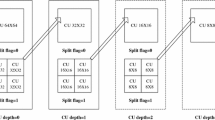Abstract
High-efficiency video coding (HEVC) has significantly improved coding efficiency; however, its quadtree (QT) structures for coding units (CU) substantially raise the overall coding complexity. This study introduces a novel complexity control scheme aimed at enhancing HEVC encoding efficiency. The proposed scheme operates across multiple layers, encompassing the group of pictures (GOP) layer, frame layer, and coding-tree unit (CTU) layer. Each coding layer is assigned a limited coding complexity based on the remaining coding time. Particularly noteworthy is the dynamic scheme implemented to activate the complexity control method. To further expedite encoding, an efficient algorithm is developed for the CTU layer. Experimental results indicate that the 0.46% and 0.98% increases in BD-rate under the target complexity are reduced to 80% and 60% of the complexity constraint, respectively. The rate-distortion performance surpasses existing state-of-the-art complexity control methods, demonstrating the effectiveness of the proposed approach in enhancing HEVC encoding efficiency.







Similar content being viewed by others
References
Sullivan, G.J., Ohm, J.R., Han, W.J., Wiegand, T.: Overview of the high efficiency video coding (HEVC) standard. IEEE Trans. Circuits Syst. Video Technol.Trans. Circuits Syst. Video Technol 22(12), 1649–1668 (2012)
Corrêa, G., Assuncao, P., Agostini, L.: Complexity control of high efficiency video encoders for power-constrained devices. IEEE Trans. Consum. Electron. 57(4), 1866–1874 (2011)
Deng, X., Xu, M., Jiang, L., Sun, X., Wang, Z.: Subjective-driven complexity control approach for HEVC. IEEE Trans. Circuits Syst. Video Technol. 26(1), 91–106 (2016)
Vermeir, T., Slowack, J., Wallendael, G. V., Lambert, P., & Walle, R. V. Real-time complexity constrained encoding. In Proc. IEEE Int. Conf.Image Process., Phoenix, AZ, USA, pp. 819–823 (2016)
Zhang, J., Kwong, S., Zhao, T., Pan, Z.: CTU-Level complexity control for high efficiency video coding. IEEE Trans. Multimed. 20(1), 29–44 (2018)
Chen, F., Wen, P., Jiang, G., Yu, M., Chen, H.: Hierarchical complexity control algorithm for HEVC based on coding unit depth decision. Eurasip J. Image Video Process. 1, 1–14 (2018)
Jimenez-Moreno, A., Martinez-Enriquez, E., Diaz-de-Maria, F.: Complexity control based on a fast coding unit decision method in the HEVC video coding standard. IEEE Trans. Multimedia 18(4), 563–575 (2016)
Grellert, M., Zatt, B., Shafique, M., Bampi, S.: Complexity control of HEVC encoders targeting real-time constraints. J. Real-Time Image Process. 13, 5–24 (2017)
Li, T., Xu, M., Deng, X., Shen, L.: Accelerate CTU partition on real time for HEVC encoding with complexity control. IEEE Trans. Image Process. 29, 7482–7496 (2020)
Huang, C., Peng, Z., Xu, Y., Chen, F., Jiang, Q., Zhang, Y., Jiang, G., Ho, Y.-S.: Online learning-based multi-stage complexity control for live video coding. IEEE Trans. Image Process. 30, 641–656 (2021)
JCT-VC: High efficiency video coding (HEVC) test model 15 (HM15) encoder description. JCTVC-Q1002, 17th JCT-VC Meeting, Valencia (2014)
Sturges, H.: The choice of a class-interval. J. Am. Statist. Assoc. 21, 65–66 (1926)
Bossen, F.: Common HM test conditions and software reference configurations. JCTVC-L1100, Geneva, Switzerland (2013)
Bjøntegaard, G.: Calculation of average PSNR differences between RD-Curves. ITU-T SG16 Q.6 Document, VCEG-M33, Austin, US (2001)
Author information
Authors and Affiliations
Contributions
The authorship contributions for this manuscript adhere to Springer's authorship policy, outlining specific guidelines for each author's involvement. As per this policy, the contributions of each author are as follows: •We design the dynamic control system •We have done all experiments •We deduce all the formula These contributions represent our statement of authorship and will be published accordingly.
Corresponding author
Ethics declarations
Competing interests
The authors declare no competing interests.
Additional information
Publisher's Note
Springer Nature remains neutral with regard to jurisdictional claims in published maps and institutional affiliations.
Rights and permissions
Springer Nature or its licensor (e.g. a society or other partner) holds exclusive rights to this article under a publishing agreement with the author(s) or other rightsholder(s); author self-archiving of the accepted manuscript version of this article is solely governed by the terms of such publishing agreement and applicable law.
About this article
Cite this article
Fang, JT., Chen, JK. Multiple layers complexity allocation with dynamic control scheme for high-efficiency video coding. J Real-Time Image Proc 21, 69 (2024). https://doi.org/10.1007/s11554-024-01452-6
Received:
Accepted:
Published:
DOI: https://doi.org/10.1007/s11554-024-01452-6




